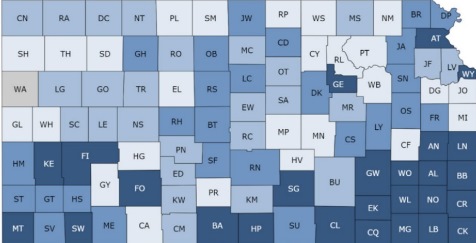by Celia Llopis-Jepsen, Kansas News Service and KCUR
The disparities between Wyandotte and its neighbor to the south — Johnson County — remain the most dramatic contrast in the state.
Residents of Wyandotte County and southeast Kansas face worse health outcomes than most of the rest of the state.
A new report of annual health rankings from the University of Wisconsin Population Health Institute considers premature death, births of low-weight newborns, mental well-being and other factors.
Southeast Kansas has struggled with poverty for generations — going back to the heyday of the region’s coal, zinc and lead mining industries. Those industries attracted immigrants willing to work dangerous jobs.
The Kansas City, Kansas, area faces the cumulative effects of redlining and racism that have hindered financial investment in neighborhoods populated by people of color for decades.
The health gap between Wyandotte and its neighbor to the south — Johnson County — remains the most dramatic juxtaposition in Kansas.
Johnson County, the state’s wealthiest county, is also its healthiest. Wyandotte is one of the least healthy. Obesity and lack of physical activity are more common among adult residents, as is premature death.
Other pockets of the state are struggling, too, including some southwest Kansas counties that rely on agriculture and meatpacking jobs, and Geary County, home to part of Fort Riley.
Ericka Burroughs-Girardi specializes in the county health rankings at the University of Wisconsin Population Health Institute.
“There is a very strong tie between wealth and health,” said Burroughs-Girardi, the project’s senior outreach specialist.
Babies are more likely to be born with a low birth weight in Wyandotte County, which can cause health problems.
“Discriminatory policies, disinvestment — all of these policy decisions — have played a role in Wyandotte and other communities that have struggled to pull themselves out of a hole,” she said, and the story of exceptionally wealthy counties next to struggling ones is common across the country.

Decades of redlining effectively threw up barriers to homeownership in communities of color and that undercut a key path to building up wealth.
The report suggests economic opportunity and living wages are critical for building healthy communities — and that even when an area has good local medical care, this alone cannot fix long-standing health inequities.
“The larger drivers of our health are the social and economic factors,” Burroughs-Girardi said, “such as income, such as education.”
The report found progress regarding local medical care. Several southeast Kansas counties saw fewer Medicare enrollees landing in the hospital with preventable situations such as uncontrolled diabetes, hypertension and bacterial pneumonia.
Jason Wesco, president of the Community Health Center of Southeast Kansas, said that improving medical care isn’t enough.
His organization has started targeting other problems in the community, such as housing instability.

“If we want people to be healthier, we can’t only operate in health care,” Wesco said. “So we’re getting … into transportation, into housing. We feed people. We are working on (combatting) social isolation. We’re doing a lot of those things.”
Several southeast Kansas counties face higher rates of smoking, childhood poverty and mental health struggles than most places in the state.
The Community Health Center of Southeast Kansas has clinics in seven counties and serves patients from even more.
“A lot of the reason why people came here in the first place was to do very dangerous work,” he said. “We have a culture here of generational poverty. It’s not a value statement, it’s just a fact. … If it’s happened for 100 years, you don’t just one day say, ‘Hey, we’re all going to be healthy.’”
Celia Llopis-Jepsen reports on consumer health for the Kansas News Service. You can follow her on Twitter @celia_LJ or email her at celia (at) kcur (dot) org.
The Kansas News Service is a collaboration of KCUR, Kansas Public Radio, KMUW and High Plains Public Radio focused on health, the social determinants of health and their connection to public policy.
Kansas News Service stories and photos may be republished by news media at no cost with proper attribution and a link to ksnewsservice.org.
See more at https://www.kcur.org/news/2022-05-18/generational-poverty-hurts-the-health-of-people-in-southeast-kansas-and-wyandotte-county.

Ask five people what economic opportunity is and you will get five different answers. “Economic” is so 1970’s sounding. I think when that particular word is heard by someone that it simply exits out the other ear.